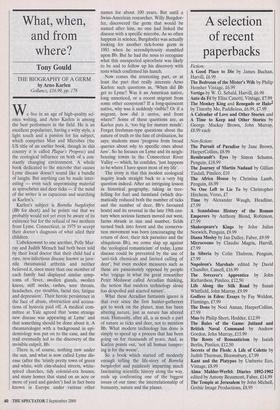What, when, and from where?
Tony Gould
THE BIOGRAPHY OF A GERM
by Arno Karlen Gollancz, £16.99, pp. 178
We live in an age of high-quality sci- ence writing, and Arno Karlen is among the best performers in the field. He is an excellent populariser, having a witty style, a light touch and a passion for his subject, which comprises Man and Microbes (the US title of an earlier book, though in this country it is called Plague's Progress) and the ecological influence on both of a con- stantly changing environment. A whole book dedicated to the microbe that causes Lyme disease doesn't sound like a bundle of laughs. But anything can be made inter- esting — even such unpromising material as spirochetes and deer ticks — if the mind of the writer is as capacious and searching as Karlen's.
Karlen's subject is Borrelia burgdorferi (Bb for short) and he points out that we probably would not yet even be aware of its existence but for the refusal of two mothers from Lyme, Connecticut, in 1975 to accept their doctor's diagnosis of what ailed their children.
Unbeknownst to one another, Folly Mur- ray and Judith Mensch had both been told by their local doctor that their child had a rare, non-infectious disease known as juve- nile rheumatoid arthritis and neither believed it, since more than one member of each family had displayed similar symp- toms of 'fever, swollen glands, swollen knees, stiff necks, rashes, sore throats, headaches, eye troubles, facial tics, fatigue and depression'. Their heroic persistence in the face of abuse, obstruction and accusa- tions of hysteria paid off. A medical com- mittee at Yale agreed that 'some strange new disease was appearing at Lyme' and that something should be done about it. A rheumatologist with a background in epi- demiology was put on to the case, and the trail eventually led to the discovery of the invisible culprit, Bb.
There is, of course, nothing new under the sun, and what is now called Lyme dis- ease (after the 'trimly pretty town of green and white, with elm-shaded streets, white- spired churches, tidy colonial-era houses, and many homes that stand on an acre or more of yard and garden') had in fact been known in Europe under various other names for about 100 years. But until a Swiss-American researcher, Willy Burgdor- fer, discovered the germ that would be named after him, no one had linked the disease with a specific microbe. As so often happens in science, Burgdorfer was actually looking for another tick-borne germ in 1981 when he serendipitously stumbled upon Bb. But he had the nous to recognise what this unexpected spirochete was likely to be and to follow up his discovery with tests which confirmed his hunch.
Now comes the interesting part, or at least the part that really interests Arno Karlen: such questions as, 'When did Bb get to Lyme? Was it an American native, long unnoticed, or a recent migrant from some other ecosystem? If a long-quiescent native, why was it suddenly visible? Or if a migrant, how did it arrive, and from where?' Some of these questions are, as Karlen puts it, 'too big for mature minds'. Forget freshman-type questions about the nature of truth or the fate of civilisation, he says; students must 'progress from broad queries about why to specific ones about how'. So he focuses on Lyme and its neigh- bouring towns in the Connecticut River Valley — which, he confides, 'just happens to be where I have spent most of my life'.
The irony is that this modest ecological inquiry leads straight back to a very big question indeed. After an intriguing lesson in historical geography, taking in tree- felling for fuel and farmland (which dra- matically reduced both the number of ticks and the number of deer, Bb's favoured hosts) and its reversal in the late 19th cen- tury when serious farmers moved out west, farms shrank in size and number, fields turned back into forest and the conserva- tion movement was born (encouraging the return of deer, their tick parasites and the ubiquitous Bb), we come slap up against the 'ecological romanticism' of today. Lyme disease could be prevented by the use of `anti-tick chemicals and limited culling of deer', but even modest measures such as these are passionately opposed by people who 'engage in what the great researcher Peter Medawar called Arcadian thinking, the notion that modern technology alone has despoiled and scarred nature'.
What these Arcadian fantasists ignore is that ever since the first hunter-gatherers got to work on the planet, man has been altering nature, just as nature has altered man. Humanity, after all, is as much a part of nature as ticks and deer, not to mention Bb. What modern technology has done is simply to speed up a process that has been going on for thousands of years. And, as Karlen points out, 'not all human tamper- ing is for the worse'.
So a book which started off modestly enough telling the life-story of Borrelia burgdorferi and painlessly imparting much fascinating scientific history along the way, ends up confronting one of the biggest issues of our time: the interrelationship of humanity, nature and the planet.


























































 Previous page
Previous page